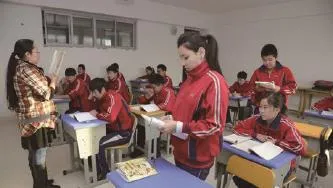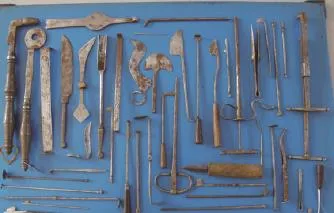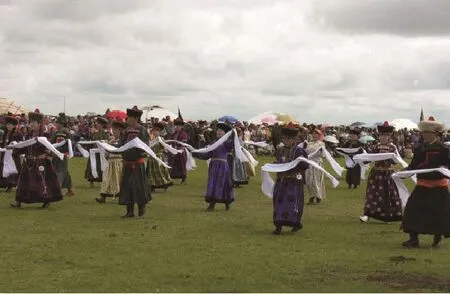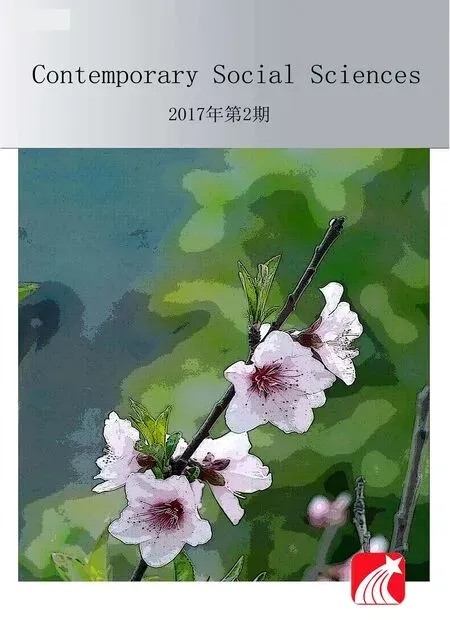The China and Mongolia Cultural Communication Status Quo and Development Trend in the Context of the Construction of the China–Mongolia–Russia Economic Corridor
2017-05-25MaYongzhenfanLijun
Ma Yongzhen fan Lijun
The China and Mongolia Cultural Communication Status Quo and Development Trend in the Context of the Construction of the China–Mongolia–Russia Economic Corridor
Ma Yongzhen fan Lijun*
As a part of the“The Belt and Road”initiative, the China-Mongolia-Russia Economic Corridor is a tailored mode of regional cooperation, combined with the construction of the Russia Eurasia Channel and the Mongolia Grassland Road. This paper analyses the Chinese and Mongolian cultural communication status quo and development trend in the Context of the construction of the China-Mongolia-Russia Economic Corridor. It then proposes that the two countries make great efforts in following three aspects to create new prosperity for China-Mongolia cultural communication and cooperation: strengthening the folk cultural communication and cooperation by consolidating its folk communication basis, vigorously promoting folk cultural diplomacy and improving the level of folk cultural communications, and consolidating the existing cooperation and creating new cultural communication through this cooperation mechanism.
The China-Mongolia-Russia Economic Corridor; Culture of China and Mongolia; Communication status quo; Development trend
On March 28, 2015, authorized by the State Council of China, the National Development and Reform Commission, the Ministry of Foreign Affairs and the Ministry of Commerce jointly issuedVision and Actions on jointly Building Silk Road Economic Belt and 21st─century Maritime Silk Road, which marked theofficial beginning of “The Belt and Road Initiative”. The China–Mongolia–Russia Economic Corridor is an important part of the International Economic Cooperation on land, based on the geographical advantage–Inner Mongolia connects Russia and Mongolia. It’s also a tailored mode of regional cooperation, combined with the construction of the Russia Eurasia Channel and the Mongolia Grassland Road. Thus, it’s not only an economic and trade corridor, but also a cultural communication and cooperation channel.
During the SCO Dushanbe summit in September 2014, the leaders of China, Mongolia and Russia held their first separate meeting, and put forward the transnational cooperation idea to build the“China─Mongolia─Russia Economic Corridor.”In July 2015, at the SCO summit in Ufa, the three leaders signed the guiding documentChina─Mongolia─Russia Tripartite Cooperation Medium─term Road─map. In June 2016, at the Tashkent summit of the SCO, the three leaders formally signedThe Outline of Constructing the China─Mongolia─Russia Economic Corridor, which implemented the guiding document and marked the beginning of this trilateral cooperation.
Highly valued by the three leaders and the Chinese government, the three countries pioneered a trilateral cooperation, and at the same time promoted the rapid development of bilateral relations and cooperation. Different from the 1990s, the cultural cooperation and communication between China and Mongolia have now been put on an important agenda.
In recent years, with the construction of the China─Mongolia─Russia Economic Corridor, cultural communication and cooperation between China and Mongolia have played an important role, and are receiving more and more attention. Culture has become a new engine to drive the economic corridor’s construction.
1. The China and Mongolia Cultural Communication Status Quo and Achievements through the Construction of the China–Mongolia–Russia Economic Corridor
With the establishment of the “China─Mongolia comprehensive strategic partnership,” the two countries have made remarkable achievements in strengthening bilateral political mutual trust, bringing economic and trade cooperation up to a new level, along with increasingly frequent cultural communication and cooperation. Bilateral cooperation in culture is becoming deeper, wider and more concrete. These are new trends and features, which involve the following points.
First is the cooperation of both sides in the constantly deepening field of education. In December 1998, to promote the cooperation in education, the two governments signedThe Agreement of Mutual Recognition of Academic Degrees and Diplomas between China and Mongolia, which was a landmark achievement. In 2010, the two countries signedThe Revised Memorandum of the Agreement of Mutual Recognition of Academic Degrees and Diplomas between China and Mongolia. This revised and supplemented the original agreement and marked the continuation of bilateral cooperation in education. The results have produced ever increasing cooperation in education.

Mongolian Students in China
There have been increases in the number of exchange students, and extended overseas study at institutions in various majors, expanding from the basic disciplines to the application of disciplines and from traditional majors to finance, network and other new fields. Over ten thousand Mongolian students have studied in China, nearly 70% of whom have a Chinese government scholarship. Also, nearly 20 million Chinese students study in Mongolia every year. This number has increased by nearly 10 times since the 1990s. These professional personnel are playing an increasingly important role in the field of bilateral cooperation between the two countries. For example, the cooperation in the field of Mongolian medicine has been a highlight in the recent two years. In China, Mongolian medicine has become an important part of Chinese medicine. Since the founding of New China, Mongolian medicine has developed comprehensively and systematically, forming an integrated productive medical system through study and research. While in Mongolia, Mongolian medicine is still traditional medicine. After the 1990s, Mongolia paid close attention to its inheritance and development. Afterward, Mongolia established cooperation with Inner Mongolia Mongolian medical institutes and colleges. Inner Mongolia Medical University trains medical talents for Mongolia every year. By the end of 2015, there were more than 500 Mongolian undergraduates and postgraduate students who had graduated from Inner Mongolia Medical University. They have become the backbones of Mongolian medicine. With the government’s close attention, Inner Mongolia International Mongolian Hospital was established in Hohhot in 2012, as the only international hospital based on traditional Mongolian medicine. This hospital treats more than 8,000 patients from Mongolia and neighboring countries per year, and has become an important entry for China to connect with Mongolia and Russia. The Inner Mongolia International Mongolian Hospital has established partnerships with many Mongolian medical institutions and has become a Chinese brand.
Second is the two sides attach importance to cooperation in cultural production and sales. In recent years, the communication and cooperation in literature and art, radio and television, press and publication and other fields have been in full swing. Besides increasing the number of mutual visits and visitors, both sides also held “cultural exhibitions,”“painting and calligraphy exhibitions,” “film exhibitions” and theatrical performances. Cultural product trades subtly rose, becoming another bright spot in this bilateral trade. China’s TV drama“Beijing Youth” was quite popular in Mongolia.
Third is carrying forward the cooperation and communication in traditional cultural fields. As Mongolia’s adjacent area, the Inner Mongolia Autonomous Region, with the advantages of geopolitical, cultural and other aspects, is cooperating with Mongolia mainly in social science, animation and national sports. They have established a good cooperative relationship and a stable bilateral cooperation mechanism.

Mongolian Medical Instruments
Taking social science as an example, since2004, relying on “Research on Grassland Culture,”the “Inner Mongolia Long–term Economic and Social Development Research Project,” “ Mongolian Language Corpus” and the “Inner Mongolia National Cultural Construction Research Project,”the Inner Mongolia Academy of Social Sciences has established close relations for academic cooperation and academic communication with The Mongolian Academy of Science, Mongolia National University, Ulaanbaatar University, the International Association for Mongol Studies and the United Nations Nomadic Civilization Research Institute. This has led to many important research results such as the publication ofResearch on China and Mongoliaand theStudy of China─Mongolia History. The Inner Mongolia Social Science organization put the project “Mongolian language Corpus Construction” into practice, making great efforts toward the construction of the world’s first Mongolian languange Corpus. “The Mongolian Language CorpusⅠ” project’s major achievement,“Mongolia Language Corpus” was reviewed by experts on November 4, 2014. It was thought to be of great benefit for future generations. The display system of “Mongolian Language Corpus” passed the assessment on December 30, 2015 and was then run on the Internet, providing many first–hand spoken language references for international Mongolian Studies. It was highly praised by Mongolian linguists. Since 2016, the Inner Mongolia Academy of Social Sciences, cooperating with Ulaanbaatar University, has implemented many projects, including “Study of Main Areas and Ways of China–Mongolia Economic Cooperation,” “The History of Mongolian Literature in the 20th Century,” “Chinese Mongolian Advanced Academic Achievement’s Transcriptions` Publication,” “Study of the Changes in Nomadic Culture in Inner Mongolia and Mongolia” and“Collection of Mongolia’s Archaeological Discoveries Since the 1990s.”
The recent cooperation results in breadth, depth, and scale have exceeded the sum of the past few decades. This shows that social science cooperation and communication is reaching a new peak between the Inner Mongolia Academy of Social Sciences and Mongolian colleges and research institutions.
Additionally, China–Mongolia cooperation in the tourist industry, including border tourism, medical tourism and independent travel, is receiving more and more attention. Tourism has the most potential for growth of any industry in the 21st century. Making a correct assessment of the situation, the two countries signedThe Tourism Cooperation Agreement between China and Mongoliain Beijing in February 2016. This is not only of great importance for border tourism, but has also injected new strength into bilateral cooperation.
Along with the increase in people’s understanding of cultural values and functions, both China and Mongolia are paying more attention to communication and cooperation in cultural fields and their positive effects. Cultural communication and cooperation have certainly been strengthened.
China and Mongolia’s cooperation and communication regarding their respective cultures, especially with the increasing folk cultural communication and cooperation and “friendship among people,” is expanding regular. Daily bilateral relations has become an indispensable in promoting the construction of the China–Mongolia–Russia Economic Corridor, highlighting the important position of China–Mongolian culture communication and cooperation in bilateral relations.
2. Strengthening China–Mongolia Folk Culture Communication and Cooperation for the Purpose of Consolidation.
Due to lack of folk and non–official communication and cooperation in the past, cultural communication and cooperation between China and Mongolia cannotbe extended within a more extensive field. Seeing this, the two sides should strengthen folk cultural communication and cooperation.
Only from national culture and traditional culture based on folk centered projects, can this bottleneck of folk cultural communication be broken. It is an important cultural event between China and Mongolia. It should also be the developing trend for the two sides’ cultural communication and cooperation.
According to Mongolia’s recent Confucius Institute poll results, many Mongolian citizens’knowledge of China is still stuck in “not knowing or understanding.” This shows that cultural communication should be the bond to strengthen mutual understanding, important for the purpose of enhancing bilateral relations. Therefore, we think, the two governments should increase official cultural communication and cooperation. On the other hand, cultural communication and cooperation should be integrated among the public. Holding more folkloric activities and allowing more projects to benefit people bilaterally are efficient ways to promote “Friendship among people.”
To create more folk cultural communication and cooperative activities, we must excavate more historical and cultural resources. We should make unremitting efforts to that end. For example, the ancient Trans Eurasian trade route, the “Silk Road,” “Grassland Road” and “Tea Road” are valuable resources for the two countries to carry forward cultural communication and cooperation. In view of this, Inner Mongolia should strengthen cooperation with Mongolian universities and scientific institutions, and strive to develop a number of high–level research projects and push forward an international study program on “The Silk Road.”
To create more folk cultural communication and cooperative activities, build a marvelous brand and create new strength for China–Mongolia folk cultural communication and cooperation, the ideas of “Friendship, honesty, benefits and capacity” must be reflected. Let us firmly establish the concept of strengthening mutual folk cultural communication, and then let bilateral folk communication always be based on “Friendship among people” to encourage increasing cooperation. After that, let China–Mongolia folk cultural communication and cooperation develop smoothly and successfully, yielding more fruitful results.
3. Vigorously Promote Folk Cultural Diplomacy and Improve the Level of Folk Cultural Communication.
As part of diplomacy, the role of cultural diplomacy has become increasingly decisive in the trends of globalization. Cultural identity has a more profound meaning and intellectual strength than political identity and social identity. Humans are the creators and carriers of culture. Human communication is intercultural communication. Along with China–Mongolia culture communication and cooperation, social science and technology included, the promotion and development of bilateral cultural industries has become a significant force that drives cultural diplomacy, especially folk cultural diplomacy.
3.1 Continuously Deepen China–Mongolia Social Science Multi–level Cooperative Research and Communication throughout a Wide Range of Fields, and Create Cultural Advantages for Cultural Industries’ Close Connections between the Two Countries.
In recent years, the two countries’ communication and cooperation in social sciences have been growing rapidly. The efforts of research and communication on Mongolian traditional disciplines and emerging interdisciplinary cooperation in various fields, extending to related Mongolian cultural industries andother fields, show possibilities of broad and promising results. All have created great cultural advantages for the combination of industries and culture, such as film and TV, the audio–visual industry, entertainment, tourism, e–books, Mongolian medicine, clothing and sports. Thus, the two sides need to formulate developmental plans for culture and industries. The two sides should combine culture and industry, creating a new system of cultural industry for national culture, animal husbandry, Mongolian medicine and tourism. This can also assist in building great brands and marketing modes, promoting the China─Mongolia cultural industry to be the most promising horizon and green industry in the 21st century.
3.2 The Precise Promotion of Folk Cultural Communication and Cooperation.
So far, there are lots of reports of the two countries’ official communication and cooperation in mass media like radio, TV and the Internet. But there are few reports of non–governmental communication and cooperation. Actually, many lovely folktales reflect the profound friendship of the two peoples. Mongolia has a population of 3 million. Nearly one million people come to China for traveling, engaging in business, for medical treatment or for studying. Meanwhile, about 200,000 Chinese work or study in Mongolia. The story told by Premier Li Keqiang during his visit to Mongolia is a typical one. In fact, there have been many such stories in recent years. For instance, the Inner Mongolia International Mongolian Hospital has a special green channel for Mongolians. Beyondthat, the hospital also regularly organizes skilled medical staffs to go to Mongolia and open free clinics. This has formed a good mechanism, and is warmly welcomed by the Mongolian patients. It also promotes friendships between the two people with consistent action. In the process of China–Mongolia cultural communication and cooperation, many inspiring stories are full of positive energy and kind deeds that are worth broadcasting. With the deepening of China–Mongolia media cooperation, there will be more such news and stories transmitted between the two countries to play a positive role in the consolidation and development of friendly relations.

Nadam Fair
3.3 Cultural Communication and Cooperation Start from the Bottom and Folk Culture.
“The Cultural Communication Program”that the two governments sign every three years is a basic document for cooperation. Within this framework, China and Mongolia respectively held “Culture Week,” “Culture Month,” and set up “The Confucius Institute” and “China Center”in Mongolia. The Nadam Fair that is held in Mongolia also attracts Chinese tourists, improving the Chinese understanding of Mongolia. During their visits to Mongolia, President Xi Jinping and Premier Li Keqiang both agreed upon and supported the setting up of the “Mongolian Cultural Center” in China, to promote Mongolian culture. Cultural communication and cooperation embody interpersonal communication. Furthermore, interpersonal communication is also a type of cultural communication. The two complement each other very well. We hope that China–Mongolia cultural communication and cooperation begin with the “Grassroots project” which benefits people’s livelihood. Both social and economic benefits should be closely integrated and carried together. In the process, folk cultural communication and cooperation should be put in a more significant position, there should be more efforts to combine these concepts with human, financial and material resources which should serve to play a more leading role. This will make China–Mongolia cultural communication a driving force in the development of a bilateral comprehensive cooperative partnership.
4. Consolidate Existing Cooperation and Create New Cultural Communication and Cooperation Modes
Compared with economic cooperation, China–Mongolia cultural communication and cooperation are just at the beginning stages. Quite a few fields need to deepen for better communication and cooperation. Based on consolidating existing cooperative achievements, the development trend for China–Mongolia cultural communication is to discover more shared traditional factors, to carry on multi–channel, multi–level and multi–form communication and to promote them comprehensively. On the one hand, we hope the two countries can implement signed cooperation documents actively and effectively in culture, education, science and technology, Mongolian medicine and other humanities. This will also strengthen the basis of cooperation. On the other hand, we should change our minds as we go into the future regarding some past ideas which may not give the full picture of, or assist in this mechanism. Following aspects should be highlighted.
First, non–governmental efforts should be admitted into China─Mongolia cultural communications and cooperation, turning from“governmental actions” into “governmental assistance” as in setting the stage for, or creating a mode of folk “governmental guidance.”
China (Shenzhen) International Cultural Industry Fair (ICIF) held in 2004, and the firstChina─Mongolia expo held in Hohhot in 2015, are good patterns of “folk governmental guidance.”This illustrated the cultural industry and its products integrated into the people’s lives of the two countries through the ICIF and Expo. This will increase an understanding of each other and play the role of“Friendship among people.”
In the past two years, with the vigorous development of science, technology and the Internet, many modes of cultural industry have sprung up quietly, such as culture and science and technology, culture and tourism, culture and manufacturing, culture and agriculture. Numerous cultural conduits will be derived from those industries. It’s the developing trend of the cultural industry, with promising marketing and broad developmental prospects.
Second, expand cooperation in the field of education. The number of exchange students appears unequal between the two countries, which is affected by factors of imbalance in economic levels, and by China's rising educational aid fund for Mongolia and their employment. Namely, the proportion of Chinese exchange students is far below that of Mongolian students in China. Most Mongolian students can be employed both in China and Mongolian. However, students studying in Mongolia return with a single employment orientation, which results in the difficulty affecting the number of Chinese students in Mongolia. With further promotion of the “China─Mongolia─Russia Economic corridor,” China should increase the number of exchange students and majors, and train professional and applied talents according to needs. For example, Erenhot International College of Inner Mongolia Normal University cooperated with the Mongolian State University of Education and The National University of Mongolia to carry on a “two and two” joint program, which is a platform that can be used for reference. Based on this joint program, the making of detailed medium and long term cooperation plans can help graduates to quickly adapt to the market. In the future, this mode can be expanded for postgraduates and doctoral students.
Third, enhance cooperation in the fields of Mongolian medicine, national music and sports. Mongolian national traditional culture is one with great characteristics. Mongolian medicine, folk dance and music, national literature and sports have great application and cultural value. These are current and future key fields that will assist China and Mongolia to strengthen cultural exchanges. Therefore, with the signed agreements, to deepen the communication and cooperation of each field is the common responsibility and mission for medical workers and cultural workers of the two countries.
In the Context of the construction of the China─Mongolia─Russia Economic Corridor, we should start with culture toward folk communication and cooperation, to construct a cultural community with the idea of “Friendship, honesty, benefits and capacity.” Let the sense of interest within communities be established in China and Mongolia and then enjoy the developing achievements and mutual benefits for China─Mongolia cultural communication and cooperation.
(Editor: Xiong Xianwei)
* Ma Yongzhen, researcher, the President of Inner Mongolia Academy of Social Sciences.
Fan Lijun, researcher, deputy director of The Institute of Russia and Mongolia, Inner Mongolia Academy of Social Sciences.
杂志排行
Contemporary Social Sciences的其它文章
- An Introduction of Sichuan Merchants
- Five Major Ethical Issues Concerning Extended Cognitive Technology
- The Multidimensional Description and Investigation of New Color Terms: A Metaphorical Cognitive Approach
- Coordination: From Development Concept to Methodology Innovation
- The Differences between Chinese and Western Cultures based on the Animal Images in Idioms
- A Modest Study on Ba Culture and Architecture
